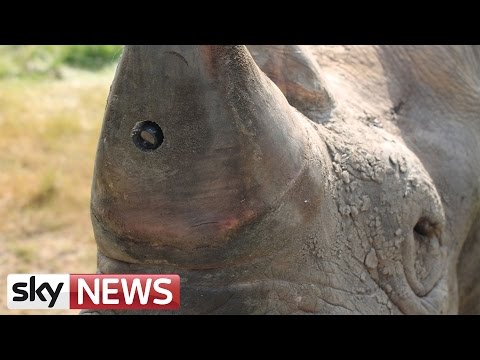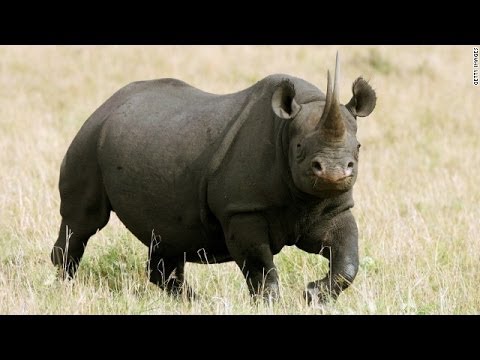So today, we’re taking a look at further issues, like how 3-D printers might put a stop to rhino poaching, how scientists are completely ignoring a species of endangered elephant, and why one millionaire hunter thinks we should save rhinos by shooting them.
10The Sad Fate Of The Northern White Rhino
It’s hard to imagine a world without rhinos. Unfortunately, these beautiful beasts are rapidly disappearing from our planet. In 2012, the Javan rhinoceros went extinct in Vietnam. In August 2015, officials declared there were no more Sumatran rhinos left in the wild. And in 2011, the western black rhinoceros was lost forever. Sadly, the northern white rhino is heading in the same dismal direction. In July 2015, a northern white rhino by the name of Nabire died of a ruptured cyst at the Czech Republic Zoo. And in November 2015, an ill female named Nola was euthanized at the San Diego Zoo. After Nola’s death, there is now a grand total of three northern white rhinos in the entire world. There are Najin and Fatu—two females—and Sudan, the very last male in existence. The trio lives in the Ol Pejeta Conservancy, a nature reserve in Kenya. They’re surrounded by armed guards, and their horns are continually trimmed to keep poachers at bay. Tragically, none of the rhinos can reproduce due to age and sickness. So the species’s best hope probably lies with the researchers at the San Diego Zoo and the Ol Pejeta Conservancy. In San Diego, scientists have several samples of rhino eggs and sperm, which they can implant in southern white rhino surrogates. If all else fails, researchers at Ol Pejeta have discussed inseminating southern white rhino females with northern white rhino sperm, creating an all-new subspecies. Thankfully, the San Diego Zoo has a pretty good track record when it comes to rescuing endangered species. They’re the scientists responsible for saving the southern white rhino and the California condor from extinction. However, this task is going to take a lot of time and a lot of money, and at the moment, no one is really sure if in vitro fertilization will work at all.
9Saving Elephants With Excrement
Samuel Wasser is the head of the Center for Conservation Biology at the University of Washington. Naturally, he’s pretty concerned about the fate of African elephants. That’s why Wasser has devised a unique way to protect these creatures. To save the species, Wasser spends his time analyzing their excrement. Watch this video on YouTube For the past 15 years, park rangers and conservationists across Africa have been scraping up elephant dung and mailing it to Samuel Wasser’s laboratory. When the packages of poop show up at his doorstep, Wasser and his team analyze the genotypes found in the feces. They use a map to pinpoint each sample’s origin. Next, Wasser and his crew analyze ivory confiscated from smugglers around the world. A lot of these shipments come from places like Taiwan, Thailand, Malaysia, and Hong Kong. Since this poached ivory shows up in places like Sri Lanka and the Philippines, law enforcement agents aren’t sure where the elephants were originally killed. If they knew where this ivory was coming from, they would have a better chance of protecting elephants before they were shot. And that’s where Wasser’s plan comes into play. After examining the confiscated ivory, he compares the ivory DNA against the elephant dung until he gets a match. Thanks to the excrement, he can then determine where the murdered elephant originally came from. Wasser’s methods are accurate, and he’s usually able to pinpoint a poached elephant within 300 kilometers (200 mi) of where it died. Wasser has identified several major hot spots in places like Tanzania, Mozambique, and the Congo Basin. With this DNA evidence in hand, rangers can focus specifically on these trouble spots in an attempt to catch poachers in the act. And it’s all thanks to Samuel Wasser . . . plus what a bunch of elephants are eating for dinner.
8WildLeaks
We’ve all heard of WikiLeaks, the organization founded by Julian Assange that publishes secret documents online. The key to WikiLeaks’s success is anonymity. Sources publish their documents in complete secrecy, protecting them from reprisal. Now, while we can debate the pros and cons of WikiLeaks, we can probably all get behind WildLeaks, its top secret conservationist cousin. WildLeaks was founded by Andrea Costa, a guy who’s had quite a bit of success protecting endangered animals. He discovered that Al-Shabbab, the terrorist group based in Somalia, was supporting its operations by smuggling illegal ivory. He also founded the Elephant Action League, a California nonprofit that fights wildlife crime. But his most fascinating contribution to the war on poaching is WildLeaks, a site where anyone can report illegal activity while remaining anonymous. Using Tor technology, users have reported everything from illegal elephant ivory in Hong Kong to tiger hunting in Sumatra. People have used the site to call attention to chimpanzee trafficking, parrot smuggling, and wolf killing near Yellowstone National Park. Since it went live in February 2014, WildLeaks has received over 70 tips. Each anonymous leak is analyzed by a group of experts, and once the information is verified, the group contacts the appropriate authorities. On three occasions, they’ve even launched their own investigations. The site truly is a global phenomenon as it supports 16 different languages, giving concerned citizens across the globe a chance to protect wildlife and bring down the wealthy crime lords behind the black markets.
73-D-Printed Rhino Horns
Rhino poaching is especially tragic because these beautiful animals are dying for absolutely no reason. In China and Vietnam, rhino horns are ground into a powder and used for all sorts of crazy purposes, from party drugs to cancer cures. But rhino horns are made of keratin—the same stuff that makes our fingernails—and have no medicinal value whatsoever. Despite this, rhino horn can sell for as much as $100,000 per kilogram. But the folks at Pembient have a plan to drive down the prices. A Seattle-based company, Pembient wants to flood the market with fake rhino horns, created with synthesized keratin and 3-D printers. With truckloads of these 3-D-printed horns, Pembient plans to overload Vietnam and China, driving down the black market prices. These fake horns are also perfectly edible, so people can consume them without any ill effects. They even plan to make beer using these horns as many people (erroneously) think rhino horn beer acts as a hangover cure. Some people, however, aren’t wild about Pembient’s plan. While proponents claim these horns will pass DNA tests, critics aren’t so sure. They worry that if Asian buyers discover the market is full of fake rhino horns, then the real things will become even more valuable.
6The Rhino Horn Camera
Plan on taking a trip to Africa? You might want to keep an eye out for rhinos sporting large leather collars. If poachers spot a rhino with a collar, they might not pull the trigger, or else they’ll end up on Conservationist Candid Camera. The Real-time Anti-Poaching Intelligence Device, also known as RAPID, is a rather elaborate system devised by a British nonprofit called Protect. While it’s a bit invasive and kind of complex, RAPID is an ingenious scheme to keep poachers at bay, all while making rhinos look incredibly chic. That leather collar comes equipped with a GPS device that keeps conservationists up-to-date about the rhino’s whereabouts. RAPID also involves planting heart monitors beneath the animal’s skin, as well as drilling a hole into the rhino’s horn. The hole is for the miniature camera, of course. Let’s say a poacher shoots a rhino. Suddenly, the animal’s heart rate either drops or skyrockets. The monitor beneath the skin immediately detects the change and activates the camera inside the rhino’s horn. The camera then records everything the rhino sees, including any hunters who might approach their prey. At the same time, the GPS collar lets authorities know where the rhino was shot so an emergency team can rush to the crime scene. Even if the poacher gets away, they’ll have his face on video. Obviously, the heart monitor needs electricity to operate, but the people at Protect have rigged up a battery that only needs to be changed a few times during the rhino’s lifespan. They’re also currently working on a device that’s powered by solar or kinetic energy. RAPID is currently being tested in the field, and if it works out, then it might be used to protect all sorts of endangered animals, from tigers to whales.
5The Forgotten Elephants That Are Going Extinct
Okay, it’s time for a pop quiz. How many different kinds of elephants are there? Just two, right? That’s what we’re all taught. There’s the African elephant and the Asian elephant, and you can distinguish between the two by their size and their ears. But it’s a bit more complex than that. According to a growing body of evidence, the African elephant is actually two distinct species: the savanna elephant and the little-known forest elephants. There’s been talk about these two species since 1900, but the idea didn’t really gain traction until 2006. British zoologist Peter Grubb examined nearly 300 African elephant skulls and found some pretty distinct differences between the two groups. Forest elephants also live in smaller groups and possess smaller ears, longer tusks, and their own unique sounds. Still not convinced? According to American biologist Alfred Roca, forest elephants and savanna elephants are so genetically different that it’s like comparing chimpanzee DNA to human DNA. So why aren’t we taught about the two different species? Major conservation groups like the International Union for Conservation of Nature (IUCN) and the Convention on International Trade in Endangered Species (CITES) refuse to acknowledge the existence of more than one species. And according to some researchers, this is posing a serious problem for the future of forest elephants. The IUCN and CITES won’t recognize the separate species for two reasons. First, these organizations claim the two elephant groups aren’t truly distinct species because forest elephants and savanna elephants can interbreed. Secondly, if they acknowledged two separate species, what would become of forest-savanna hybrids? If there were only legal protections for savanna and forest elephants, how could you protect their offspring? So instead of recognizing two distinct species, these organizations group them together as the “African elephant,” thus providing legal protection for forest-savanna hybrids. However, many scientists beg to differ with these conservation groups, pointing to examples of interbreeding species like wolves and coyotes. Plus, they claim there’s a bigger problem than forest-savanna hybrids. By only recognizing one species, the IUCN and CITES can say that while there’s major poaching in some parts of Africa, elephant populations are much more stable in other regions. Sure, African elephants in the forest are dying, but it equals out because the ones in the savanna are doing better. That might make sense if there’s just one species. But if there are two, then that poses a problem. Approximately 60 forest elephants died every single day between 2002 and 2013, leaving only 100,000 left alive. But since they aren’t viewed as a separate species, forest elephants are hovering on the brink of extinction.
4Taking Rhinos To Texas
They say everything is bigger in Texas, and if the Exotic Wildlife Association (EWA) gets its way, that’ll include the wildlife. In May 2015, the EWA teamed up with Group Elephant to present a rather peculiar proposal. The EWA wants to load up a bunch of rhinos into airplanes, fly them over the Atlantic, and let them loose on the Lone Star State. And we’re not talking about just a few rhinos. We’re talking about 6 percent of the entire population of South Africa. Really, it’s a pretty straightforward idea. The EWA and Group Elephant want to cut a deal with the private ranchers who own thousands of South Africa’s rhinoceroses. If the ranchers agree to let their rhinos fly to the states, they’ll have partial ownership of any calves sired by their stock. Plus, once the rhinos show up, they’ll be protected for life, and that extends to their offspring. This plan does pose a couple of problems. First, enough Texas ranchers have to agree to care for the approximately 1,000 rhinos. Secondly, flying these four-legged tanks isn’t going to be easy or cheap. Your typical plane can hold about five rhinos at a time, and it costs approximately $50,000 to move just one of these hulking mammals across the ocean. But if the US Department of Agriculture approves, the EWA plans on transporting as many rhinos as possible, bringing them to Texas where they can repopulate in relative peace.
3The Black Mambas
You don’t want to mess around with a Black Mamba. And no, we’re not talking about the deadly African snake (or the katana-wielding, jumpsuit-wearing assassin). We’re talking about the all-female team of South African rangers who patrol the Balule Nature Preserve. They’re incredibly effective even though they don’t carry weapons, and in the last few years, they’ve put a major stranglehold on local poachers. Balule is a private nature reserve inside the Greater Kruger National Park. The head warden is a guy named Craig Spencer, and in 2013, he hired 26 out-of-work women and trained them to become the Black Mambas as a way to protect wildlife and win over local, impoverished communities. Wearing military uniforms, these women are tasked with keeping the 40,000-hectare reserve safe from armed hunters. They spend their day patrolling the park, walking up and down the fence that surrounds the reserve. They watch out for any unwanted activity and set up listening posts to spy for suspicious sounds. And if they find any illegal activity, they radio for backup, and the armed guards show up. This is all pretty risky as the Black Mambas don’t carry their own guns. But these women are effective. In 2015, the United Nations Environment Program awarded the Mambas with the Champions of the Earth Award, one of the highest environmental prizes in the world. In the last few years, they’ve captured at least six hunters and cut back on snare poaching by a whopping 76 percent. So if you’re a poacher, you might want to stay out of Balule. It’s Black Mamba territory.
2John Hume’s Controversial Plan
It’s fair to say that John Hume is a controversial fellow. A South African rancher, John currently raises over 1,000 black and white rhinoceroses. According to the online magazine Guernica, he might have the biggest private rhino herd in the world, and he plans on breeding hundreds more. Without a doubt, Hume is concerned about the future of these magnificent animals. That’s why he employs ex-military personnel to protect his herd from poachers. John also keeps his rhinos safe by cutting off their horns. It’s a painless process, and the horns are constantly growing back, much like a gigantic fingernail. If the rhinos don’t have massive horns, they’re less of a target for hunters. But this is where things get a bit contentious. True, Hume wants to protect the rhinoceros, but he wouldn’t mind making a little bit of money on the side. So whenever it comes time to dehorn one of his animals, John adds the horn to his ever-growing stockpile. At the moment, the man owns four tons of the stuff, which is worth around $235 million. But he can’t sell any of his horns because South Africa banned the buying and selling of rhino horn in 2009. John has a fortune in his backyard, and he can’t spend it. That’s why Hume is fighting to overturn the ban. This isn’t just about money. It’s also about protecting rhinos from extinction. John believes if the government legalized the rhino horn trade, it would give people incentive to breed and protect the animals. It would also drive the price of rhino horn down, devaluing it as a status symbols and giving poachers fewer reasons to pull a trigger. Hume has faced a lot of criticism for his stance on this issue. Groups like Stop Rhino Poaching vehemently oppose ranchers who stockpile rhino horns. Many critics say that legalizing the sale of rhino horn would allow people to buy the horn of poached rhinos, and that poaching plus legalized ranching would speed up rhinoceros extinction. Hume would respond that in 2007—before the ban—only 13 rhinos died in South Africa. In 2014, the number was more like 1,200. However, things took an interesting turn in November 2015 when a judge overturned the domestic ban on rhino horns. South Africa’s environment ministry is challenging the decision, which means the ban will probably stay in place for the time being. And as South Africa hashes over this tricky situation, the Convention of International Trade in Endangered Species of Wild Fauna and Flora (CITES) is actually considering lifting the international ban on rhino horn in 2016. Chances are good John Hume is seeing dollar signs right now, but regardless of what happens next, let’s hope it all ends well for the rhinos.
1Corey Knowlton, The Rhino Hunter
When it comes to controversy, Corey Knowlton makes John Hume look like the most popular man on the planet. Knowlton is a Texas millionaire, the heir to an oil fortune, and from January 2014 to May 2015, he was one of the most hated men in the world. Knowlton paid a large amount of money to kill a black rhinoceros. But if you asked him why he did it, the answer might surprise you. The story starts in January 2014, when the Dallas Safari Club was auctioning the chance to fly over to Namibia and bag a black rhino. The whole thing was perfectly legal as the Namibian government was providing a tag for one lucky hunter to take the ultimate safari. While Knowlton didn’t intend to buy the tag, he did offer $350,000 to get the bidding started. No one else offered up any money—possibly scared of the potential media firestorm—and Knowlton was soon planning his hunting trip to Namibia. This didn’t sit well with the animal-loving public. Knowlton was attacked by celebrities like Mia Farrow and Ricky Gervais, and the US Fish and Wildlife Service took over a year to approve Knowlton’s request to bring his trophy back to the states. Even worse, the man received a barrage of death threats. People threatened to torture his children, set his house on fire, and rape his wife to death. Despite the criticism, Knowlton flew to Africa in May 2015 and shot a black rhino, once again making headlines around the world. But this is where things start to get tricky. It’s easy to paint Knowlton as a monster with bloodlust, but the truth is a lot more complicated. According to Knowlton, hunters are the only people who truly care about endangered animals, and if it weren’t for hunters, rhinos would’ve gone extinct a long time ago. First, Knowlton didn’t get to shoot just any rhinoceros he came across. He was only allowed to kill one animal, and it had to meet a very specific criteria set by the Namibian government. Knowlton could only kill an elderly rhino that could no longer reproduce. Also, his prey needed to be a “problem rhino,” an aggressive male that killed younger, virile rhinos. Secondly, Knowlton was shelling out $350,000 for the right to hunt a rhino. According to Knowlton, the Namibian government takes that money and uses it to protect younger animals with reproductive capabilities. This money is used to hire rangers and researchers and to keep the preserves pristine and protected. Knowlton isn’t the only hunter willing to pay thousands of dollars for the right to hunt. This kind of thing happens all over the world with all sorts of species, and the money goes right back into conservation programs. All this money adds up into millions of dollars going to keep these animals alive. By putting a price on elderly rhinos, Knowlton believes hunters are creating an economic incentive to keep the species alive as well as providing funding for the people who want to protect these creatures from poachers. After shooting his black rhino, Knowlton gave most of the meat to a local, impoverished village. Of course, conservationists like Richard Leakey claim these practices are abominable. Killing rhinos—no matter the reason—sends the wrong message. And as National Geographic points out, the money sometimes ends up in the wrong places due to government corruption. But before you send a nasty letter to Mr. Knowlton, remember all the reasons he’s pulling that trigger and consider whether it’s worth sacrificing a few rhinos for the future of an entire species. Nolan Moore is a freelance writer from Texas. If you want, you can friend/follow him on Facebook or send him an email.
























